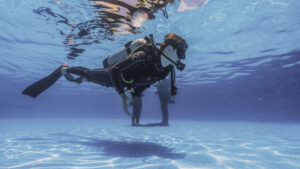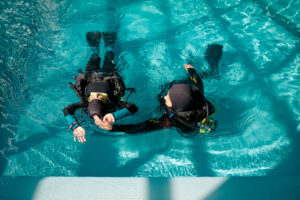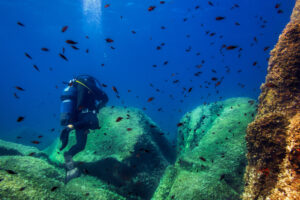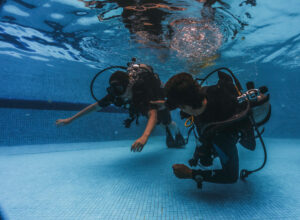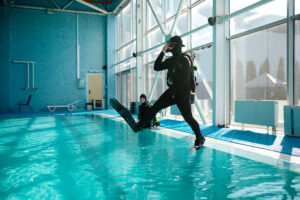What is a Dump Valve?
A dump valve, also known as a bleeder valve, is an essential component of a buoyancy control device (BCD) used in scuba diving. Its primary function is to allow divers to release air quickly from their BCD in certain situations, such as during an emergency rapid ascent. This entry will explore the design, function, and safety measures of a dump valve, with a particular emphasis on its role in ensuring a safe and enjoyable diving experience.
Design and Location
The design of a dump valve is relatively simple, typically consisting of a one-way valve mechanism that is normally closed but can be manually opened to release air from the BCD. They are often constructed from durable, corrosion-resistant materials to withstand the pressures and conditions of underwater environments.
In terms of location, dump valves are usually positioned in strategic areas on the BCD for easy access and optimal functionality. The most common placement is on the shoulder of the BCD, where it can be conveniently accessed by the diver. However, some BCD models feature a second dump valve located behind the kidney area. The placement of this second valve can offer an additional level of control during various diving maneuvers, especially when the diver is in a horizontal or inverted position.
Function and Use
The dump valve’s primary function is to allow for quick deflation of the BCD, a critical feature when a rapid ascent is necessary. By pulling the valve’s toggle, the diver can quickly release air from the BCD, reducing buoyancy and enabling a controlled descent or preventing an uncontrolled ascent.
In a typical diving scenario, divers inflate their BCDs at the surface for positive buoyancy, making it easier to stay afloat while preparing to descend. Once underwater, divers gradually release air from the BCD through the dump valve to achieve neutral buoyancy, facilitating a smooth and controlled dive. The dump valve is also used for micro-adjustments of buoyancy during the dive, ensuring the diver maintains an appropriate depth.
Safety and Buddy Checks
The dump valve is a critical safety component of the BCD. In the event of an emergency, such as equipment failure or sudden changes in depth due to currents, a quick-release of air can prevent a dangerous rapid ascent, which could lead to decompression sickness or “the bends.” Thus, ensuring that the dump valve functions correctly is a vital part of pre-dive safety checks.
During the buddy check procedure, or BWRAF (Begin With Review And Friend), divers are encouraged to check their BCD’s dump valve(s). The common practice is to inflate the BCD with air and then pull the dump valve’s toggle. If functioning correctly, the diver should feel some air releasing from the BCD. This check ensures that the valve is working properly and can perform its essential function when required.
Maintenance
Regular maintenance of dump valves is crucial for their longevity and proper functioning. After each dive, they should be rinsed thoroughly with fresh water to remove any salt, sand, or other debris that may impair their performance. It’s also recommended to periodically check the valves for any signs of wear or damage, and they should be serviced regularly by a qualified technician.
Advanced Uses and Skills
While the dump valve’s primary function is straightforward, understanding and mastering its use can provide divers with a finer level of control over their buoyancy. Particularly, experienced divers leverage the strategic locations of the dump valves to manage their buoyancy in various orientations.
For example, when a diver is in a horizontal position (also known as “trim”), the shoulder dump valve might not be the most effective way to vent air. In this case, the rear or kidney dump valve, being the highest point on the BCD, can be utilized for more efficient air release. Similarly, when inverted during a head-down descent or when exploring under overhangs, the shoulder valve becomes the highest point and thus the prime option for venting air.
Dump Valve Variations
Dump valves are not all the same. Different BCD designs might incorporate different types of dump valves. While the pull-to-dump valve, activated by pulling a cord, is standard, other types include the exhaust valve, located on the inflator hose and activated by pressing a button or pushing the hose downwards; and the over-pressure valve (OPV), which automatically releases air when the BCD reaches a certain level of inflation, thus preventing over-inflation and potential BCD damage.
Some BCDs also feature adjustable dump valves, allowing the diver to change the tension on the valve. This feature can be useful in different diving conditions, for instance, adjusting for a heavier wetsuit or a stronger current.
Innovation and Future Developments
As with most dive equipment, dump valves have seen various improvements over the years, and further advancements are anticipated. Design enhancements aim for easier use, better durability, and increased safety. For example, some manufacturers have developed visually enhanced toggles, making the dump valve easier to locate, especially in low-visibility conditions.
Future developments may focus on integrating smart technologies into the dump valve design. These could include automated systems that react to changes in pressure or depth, potentially offering even greater precision in buoyancy control and additional safety features.
Caveats and Training
While the dump valve is a crucial piece of equipment for safe scuba diving, its use must be balanced with proper training and caution. Over-reliance on dump valves for buoyancy control, particularly in emergency situations, can lead to dangerous situations such as rapid ascents. Therefore, divers should always receive adequate training on their equipment and practice their skills regularly, including buoyancy control and emergency procedures.
Moreover, divers should understand that the dump valve is not a substitute for proper diving practices, including monitoring depth and no-decompression limits, adhering to safe ascent rates, and maintaining good physical condition.
Key Takeaways
In essence, the dump valve is an indispensable feature of the BCD, contributing significantly to the safety, control, and enjoyment of scuba diving. By understanding its design, function, and the importance of regular checks and maintenance, divers can ensure they are well-prepared for a variety of underwater scenarios. As with all scuba equipment, proper training and familiarization with the dump valve’s operation are vital to ensure a safe and memorable diving experience.










